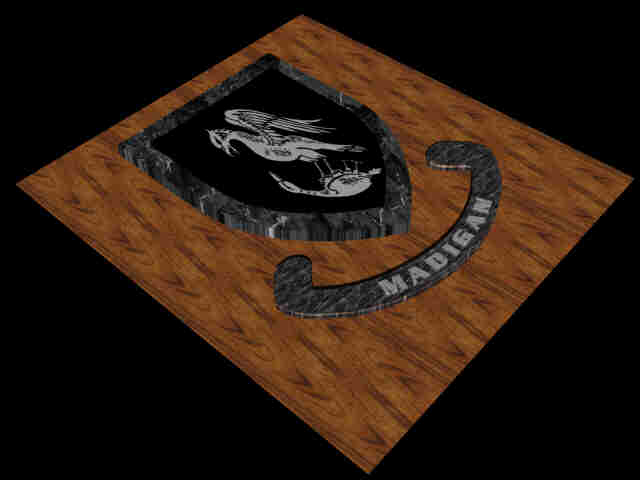That was good enough for
me and soon we were all on the mountain working our way up. At
the first small summit, we met some rock climbers and as the map
failed to identify the location of any paintings, we asked for
directions. The information was vague and the consensus was that
there were some paintings near the top of the mountain slightly
off to the left. Returning to the climbing 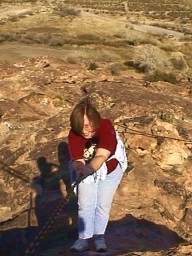 chain, we slowly made our way up. The last
couple of feet were really steep and required some effort and a
little courage to overcome. Finally, we rested at the summit. Now
it is pretty well known that ancient rock paintings, exposed to
the elements disappeared long ago. The only remaining ones are
tucked up under, around or behind rock formations. This requires
a lot of bending and crawling on knees if one ever hopes to find
the secluded designs. While Lynn went one way, I went the other.
The girls remained at the summit point to explore the immediate
area. After sticking my nose in this crevice and under that
boulder for a while I returned to see what the others had
discovered. The answer was the same, nothing. It was time to try
a different approach, we began shouting to others we could see,
asking if they had found any paintings. All responses were
negative. It began to look like the trip was a bust, when over
chain, we slowly made our way up. The last
couple of feet were really steep and required some effort and a
little courage to overcome. Finally, we rested at the summit. Now
it is pretty well known that ancient rock paintings, exposed to
the elements disappeared long ago. The only remaining ones are
tucked up under, around or behind rock formations. This requires
a lot of bending and crawling on knees if one ever hopes to find
the secluded designs. While Lynn went one way, I went the other.
The girls remained at the summit point to explore the immediate
area. After sticking my nose in this crevice and under that
boulder for a while I returned to see what the others had
discovered. The answer was the same, nothing. It was time to try
a different approach, we began shouting to others we could see,
asking if they had found any paintings. All responses were
negative. It began to look like the trip was a bust, when over 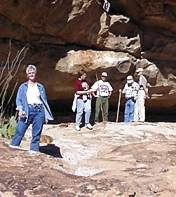 the
hill, just in the nick of time, came the Calvary. Literally, two
rock climbing soldiers from nearby Fort Bliss descended down next
to us. Wes Carlson of Evergreen, Colorado and Dan Moore of Clay,
West Virginia, couldn't have been more helpful had they been park
rangers. After a short discussion on the painting they decided it
would be easier to take us to them rather then try for a lengthy
list of directions, and so off we went. Within time we halted in
front of a rock base. Nothing spectacular about the area and
nothing showing. We joined our guides on our knees and looked up
under a ledge and there it was in all its sparkling yellowish
orange. A 1000 year old painting, hidden away from prying eyes,
to be seen only by those with the knowledge to find it. The
satisfaction was gratifying. I had accomplished what I had set
out to do. It was good.
the
hill, just in the nick of time, came the Calvary. Literally, two
rock climbing soldiers from nearby Fort Bliss descended down next
to us. Wes Carlson of Evergreen, Colorado and Dan Moore of Clay,
West Virginia, couldn't have been more helpful had they been park
rangers. After a short discussion on the painting they decided it
would be easier to take us to them rather then try for a lengthy
list of directions, and so off we went. Within time we halted in
front of a rock base. Nothing spectacular about the area and
nothing showing. We joined our guides on our knees and looked up
under a ledge and there it was in all its sparkling yellowish
orange. A 1000 year old painting, hidden away from prying eyes,
to be seen only by those with the knowledge to find it. The
satisfaction was gratifying. I had accomplished what I had set
out to do. It was good. 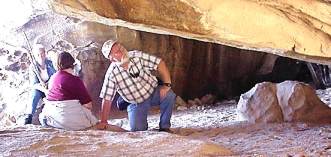 We soon found out that this example of Indian
art was the only item on top of the mountain, and so we hung
around for a while taking each other's pictures and exchanging
names. The troops needed to get back to base and started to
depart leaving us with instructions on where the "BIG"
show was near the base of the mountain. Nimble legged Lynn who
was the only one who could keep up with these boys, decided to
make the rapid descent with them and on the way
We soon found out that this example of Indian
art was the only item on top of the mountain, and so we hung
around for a while taking each other's pictures and exchanging
names. The troops needed to get back to base and started to
depart leaving us with instructions on where the "BIG"
show was near the base of the mountain. Nimble legged Lynn who
was the only one who could keep up with these boys, decided to
make the rapid descent with them and on the way 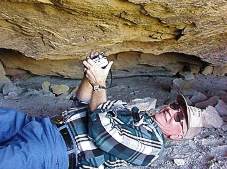 they
would show him where the main attraction was. The rest of us made
a slow and careful descent down the chain until we caught sight
of Lynn near the bottom. He led us to what looked like a cave
opening, but was actually a long low slit in the rock. On hands
and knees we worked our way into the center where we could sit up
and look around. The slit continued on for another 30 feet or so,
narrowing down to only a few feet of clearance. To a casual
observer, it was nothing but a slit in the rock, but Lynn had
worked his way around on his back and had discovered the ceiling
was covered with beautiful, intricately designed, rock paintings,
hidden away for centuries from damaging winds and prying eyes.
Much of the
they
would show him where the main attraction was. The rest of us made
a slow and careful descent down the chain until we caught sight
of Lynn near the bottom. He led us to what looked like a cave
opening, but was actually a long low slit in the rock. On hands
and knees we worked our way into the center where we could sit up
and look around. The slit continued on for another 30 feet or so,
narrowing down to only a few feet of clearance. To a casual
observer, it was nothing but a slit in the rock, but Lynn had
worked his way around on his back and had discovered the ceiling
was covered with beautiful, intricately designed, rock paintings,
hidden away for centuries from damaging winds and prying eyes.
Much of the 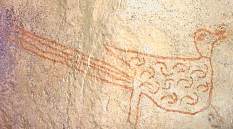 ceiling was covered, and we had to move around
quite a bit to see it all but it was worth it. What a find. For
the next hour we searched and photographed most of the ceiling.
Although there were dozens of people prowling around on the rocks
above no one entered the cave-like area. We seemed to have the
place to ourselves for as long as we liked. Having seen all we
could see, we withdrew from the area, leaving no trace of our
passing, satisfied that we had indeed seen something special,
thanks to a couple of neat guys who took the time to help.
ceiling was covered, and we had to move around
quite a bit to see it all but it was worth it. What a find. For
the next hour we searched and photographed most of the ceiling.
Although there were dozens of people prowling around on the rocks
above no one entered the cave-like area. We seemed to have the
place to ourselves for as long as we liked. Having seen all we
could see, we withdrew from the area, leaving no trace of our
passing, satisfied that we had indeed seen something special,
thanks to a couple of neat guys who took the time to help.
*** THE END ***

